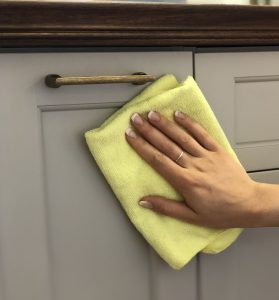 Kitchen cabinets, much like fine wood furniture, should be routinely maintained and cleaned so that the finish lasts a lifetime. For both painted cabinets and stained cabinets, care instructions are the same.
Kitchen cabinets, much like fine wood furniture, should be routinely maintained and cleaned so that the finish lasts a lifetime. For both painted cabinets and stained cabinets, care instructions are the same.
Basic Cleaning:
Using a clean, dampened cloth, wipe down cabinetry and promptly dry. For grease, oil, or food residue, use a mild dish washing solution. Spills or food residue should be cleaned off cabinetry immediately because they can become difficult to remove if left on for long periods of time. Use a blotting motion to remove residue rather than a wiping motion. Do not use a daily dishcloth to clean cabinetry because it may contain remnants of detergents that could risk damaging the cabinets.
Avoid Using Harsh Chemicals:
Do not use cleaners containing bleach, ammonia, citrus products, citric acid (such as orange and lemon oil), self- polishing products, products containing silicone, organic solvents, harsh detergents, mineral oil, or waxes.
Avoid Excessive Moisture:
Moisture is the most common cause of damage to cabinetry finishes. If the cabinetry is exposed to moisture, dry off areas immediately. Cabinetry near the sink, dishwasher and baseboards are most susceptible to water damage. Avoid putting wet dishes in cabinets and hanging damp dish clothes over cabinetry doors.
Avoid Humidity & Temperature Extremes:
Naturally wood expands and contracts with varying humidity and temperatures. This can cause the finish to crack or the wood to warp and/or dry out. Cracking is normal but much more obvious in painted finishes rather than stained finishes and can be minimized with year-round temperature control. The optimal level for humidity is between 35%-50%. Use dehumidifiers or humidifiers if necessary to keep humidity at optimal level. Avoid steam to directly flow on cabinets such as coffee makers, crock pots, or cooktops. Prior to delivery of cabinetry, make sure room is at a controlled mild temperature (between 64-75 degrees).
Avoid Chips & Scratches:
Do not use cleaning tools such as steel wool, “stiff” towels (which can leave tiny scratches on surface of finish), sharp objects, etc.
Remediation & Touch-Up Instructions:
All Heritage Woodworks customers, upon installation, will receive a touch up kit containing a fill stick and touch-up paint. The fill stick and paint should be used to touch up any areas where a chip or scratch may occur. A phillips screw driver should be used to make any minor door adjustments. It is normal for doors to vary in alignment over time after continual use and house settling.

